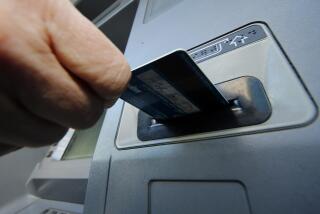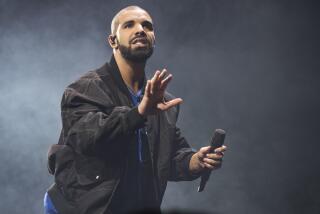U.S. Responds to Rising Threat of Counterfeiters
- Share via
WASHINGTON — Giori Eshkol was a struggling artist in Los Angeles, unable to attract a big following among the city’s haute art galleries, when he struck on an alternative use for his talent: counterfeiting $20 bills.
Eshkol used a flatbed color scanner and an IBM personal computer to create an electronic image of a $20 bill, which he touched up with a light pen. Secret Service agents foiled his scheme, and he was later convicted of counterfeiting.
The techniques used by Eshkol are on the leading edge of a trend that has Treasury Department officials deeply worried: Advanced technology is enabling every dishonest computer nerd to open a counterfeiting shop.
They are called “casual counterfeiters,” people who would use scanners, personal computers and color printers to fabricate a little spare cash. With 5 million color printers operating in the United States, the rare crime of printing fake money is threatening to become as common as shoplifting or software pirating.
“There is a rising threat as a result of new technology,” Treasury Secretary Robert E. Rubin said in an interview. “The ability of our currency to remain counterfeit-proof is very important.”
A recent National Research Council report estimated that the volume of counterfeit bills produced with advanced technology has doubled every year since 1989 and at the current growth rate will hit $2 billion by the year 2000, a tenfold increase from total current counterfeit production.
Although the greenback dominates world markets--indeed an estimated 66% of the $380 billion of U.S. currency is held overseas--it is among the least sophisticated currencies in terms of anti-counterfeiting technology.
But not for much longer.
The Treasury Department is scheduled to unveil on Wednesday a newly designed $100 note containing up to 14 new features that copiers or color printers cannot easily replicate. The new bill will include a watermark in the paper, ink that will change color depending on the angle of reflected light and a larger picture of Benjamin Franklin that will be moved off center, federal officials say.
The watermark, a design embedded into the fabric of the paper, would be visible only when held up to light and cannot be printed onto a fake bill with a computer printer or any traditional process.
Similarly, new color-changing inks don’t work in computer printers. The larger picture of Franklin will allow engravers to create more detail, a feature tough for counterfeiters to match. And moving the picture off center will allow space for the watermark and a new enhanced security thread embedded into the paper.
The Treasury Department also has plans for two high-tech features held as national security secrets, known only to key federal officials, said Thomas Ferguson, the research chief at the Bureau of Engraving and Printing. The secret features would enable high-speed machines used by the Federal Reserve for routine cash handling to more effectively ferret out the best of fake bills.
Expensive Upgrade
The enhancements to the greenback won’t come cheap. All U.S. bills will be updated in several years with the new technology, boosting printing costs by 25%, or $100 million annually for the 9.7 billion notes the bureau prints.
The existence of widespread counterfeiting is what led to the formation of the Secret Service more than 130 years ago. President Abraham Lincoln established the agency during the Civil War at a time when a third of the U.S. currency in circulation was fake.
Counterfeiting, while not a major problem, is growing again. Secret Service officials say that $25.3 million worth of bogus bills entered circulation in 1994, up sharply from $6.9 million in 1985.
Far more fake currency is seized before it even gets into circulation. Earlier this month, Secret Service agents and Canadian police made the biggest bust in history, raiding a Montreal printing operation and seizing $100 million in forged U.S. bills.
Evidence is also surfacing that foreign enemies have engaged in counterfeiting. A 1993 congressional report asserted that Iran used highly advanced methods to produce millions of nearly perfect $100 notes and distributed them through terrorist channels.
The problem is not just the loss to banks and individuals who get stuck with bad money, but the potential to undermine confidence in the currency itself. So even small increases in counterfeiting can have a disproportionate effect on public psychology, according to the National Research Council report.
“The increased availability of advanced color copiers and systems composed of a computer-scanner and printer makes widespread counterfeiting of U.S. bank notes a real and substantial threat,” the report says.
Aside from the symbolic importance of the greenback, American taxpayers get a $13-billion windfall in interest earnings from securities held by the Federal Reserve against currency that circulates abroad, according to Theodore Allison, the Federal Reserve official responsible for issuing currency.
With so much at stake, the Treasury Department hopes the new currency will nip casual counterfeiting before it gets widely established. Once casual counterfeiting gets established, it would be very difficult to police.
Low-Volume Fakery
Historically, counterfeiters have used offset presses that could churn out a lot of bills. The high volume makes it relatively easy to trace the bills (which generally have the same serial number) back through the distribution network of wholesalers and petty street criminals.
But the new breed of casual counterfeiters is changing the calculus, because they print relatively small volumes and pass them randomly. Some savvy counterfeiters have survived in business for more than a decade by keeping their volume low, Secret Service officials acknowledge.
New vending machines that accept $10 and $20 bills are a particularly easy target for casual counterfeiters because the machines “either accept the bogus bill or unobtrusively return it to the counterfeiter,” the National Research Council report warned.
Until now, the government’s battle against counterfeiting has been remarkably successful, reflecting a massive law enforcement effort. The Secret Service has branches in every major U.S. city and some foreign capitals. Los Angeles, a hotbed of counterfeiting, has 120 agents, said Jim Bauer, the Los Angeles Secret Service chief.
The conviction rate for counterfeiters is 99.5%, according to James D. Davidson, assistant special agent in charge of the Secret Service’s counterfeit division. “We try to make it more attractive to do something else,” he said.
But improvements in graphics technology and falling prices will inevitably raise the threat that more people will attempt casual counterfeiting, said Annette Jaffe, Apple Computer’s principle scientist for imaging and a co-author of the National Research Council report on high-tech counterfeiting.
“These $800 printers can do remarkable things,” Jaffe said. “The technology now enables an amateur to make a good counterfeit. Before you had to know how to make plates and operate presses.”
Genuine money is printed on intaglio presses that exert 15 to 20 tons of pressure on each sheet of paper, creating sharp details and an embossed feel that are virtually impossible to duplicate.
High-tech counterfeiters are getting better too, forcing the bureau to make more changes. In 1990, the bureau introduced a security thread in larger bills and began using so-called microprinting. But another update is already needed.
“Better technology results in a better criminal,” said Ferguson, the research chief at the bureau. “You build a fence and they get a ladder. You build a higher fence and they get a higher ladder.”
Several years ago, color office copiers were considered a big threat. Manufacturers responded with special computer chips that disable the machines if they are used to copy certain U.S. and foreign bills. Now the big threat in high-tech counterfeiting is seen in computer systems.
The resolution of color scanners and color ink-jet printers is measured by the number of dots per inch they produce. Scanners and printers that can produce 1,200 dots by 1,200 dots per square inch can produce a passable bill.
Bad Money, Dim Bars
But even remarkably bad counterfeits manage to pass, particularly at places like fast-food restaurants, where teen-age clerks are relatively unfamiliar with the look or feel of true cash. Dark bars are legendary for taking bad money.
The amount of computer and copier counterfeiting is still relatively small, estimated two years ago to be about $6 million to $8 million, but is doubling every year.
Earlier this year, Garish Chovan, a Mission Viejo resident, was arrested trying to pass a fake $20 bill that he produced at home with his color scanner and color bubble-jet printer, according to Secret Service officials.
Chovan was caught trying to pass the $20 bill at the same Sears store where he had passed another $20 just the day before. The folly was compounded because his wife worked at the store. After pleading guilty, Chovan was fined $1,000 and given three years of supervised probation.
Eshkol, the Los Angeles artist, wasn’t so lucky. He pleaded not guilty, asserting that the electronic image of the $20 bill he created was a work of art, according to federal prosecutor Patrick Fitzgerald. But the jury did not believe his story and federal Judge William Keller sentenced him to 33 months in prison earlier this year.
Guy Iversen, Eshkol’s attorney, said his client is an “accomplished artist” who was “railroaded” by Keller. Eshkol is free, pending an appeal.
Since the incident, Eshkol has turned his attention to producing a large poster of Moses and has landed a job at a Hollywood graphics studio, where he produced some of the glitzy visual effects for the last Academy Awards show.
“It is very impressive work,” Iversen said.
More to Read
The biggest entertainment stories
Get our big stories about Hollywood, film, television, music, arts, culture and more right in your inbox as soon as they publish.
You may occasionally receive promotional content from the Los Angeles Times.











